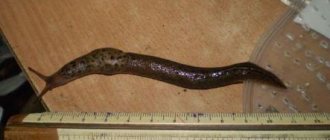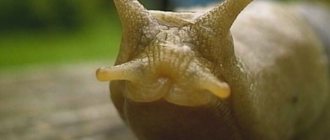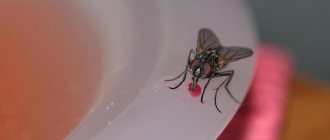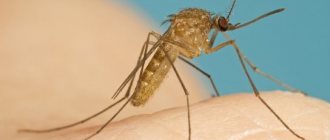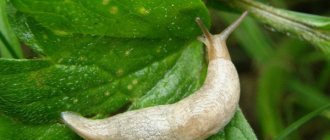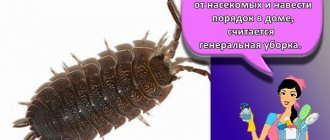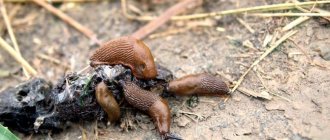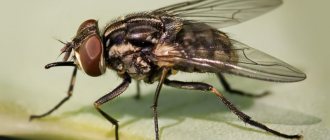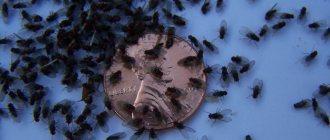A note for homeowners and a note for housewives - everything about slugs in the house, everything about methods for eliminating them. How to get rid of slugs in a private house and in urban housing, the best methods and means. About modern chemical protection products, about traps and bait, about home and folk tricks. And - about why slugs settle in the house, and how to prevent their appearance.
Appearance and where do slugs come from in the house
Slugs are gastropods that have lost their shells during evolution. They can be found in any region of the planet with a mild and humid climate. The snail's body is wrinkled.
It can range in color from yellow-white to light gray. There may also be black spots or longitudinal stripes on the body of mollusks. There are 4 processes on the head. They are shaped like horns.
Slugs live in gardens, fields, and orchards, but can also enter the house. Thanks to their flexible body, which can take any shape, mollusks can penetrate the narrowest crevices.
If there are cracks in the foundation of a house, this is a guarantee that the house will soon have new, disgusting-looking tenants.
Since the humidity in the bathroom and toilet is the highest in the house, these are the areas where slugs are most likely to be seen. Therefore, in order not to later look into where slugs are in the house, if they are detected on the site, it is necessary to block their passage into the house and other buildings in advance.
Brief descriptions of common slug species
The common naked slug has a yellow-white or gray-pink smooth body. Its size can reach 6 cm. Its habitats are forests and summer cottages. Vegetable beds suffer the most from it.
The netted field slug has a wrinkled body that is yellow-white or brown in color. On its back and mantle there are many black streaks and spots of the same color. The length of an adult parasite is 5-6 cm.
It is not as harmful as the common slug, but it also prefers to feed in vegetable beds.
The naked slug brown arion has a body covered with dense skin. There are 24 rows of small wrinkles on each side. The color is reddish or yellow-orange, and the back is brown.
On the side there are two dark stripes with blurred contours. The length can reach 7 cm. This species is widespread in both northern and southern latitudes.
Damage from slugs
Slugs are creatures that can cause quite significant damage to a family. If they appear in the house, indoor plants will suffer: slugs damage stems and eat leaves.
Garden and field crops are also affected by the pest. Mollusks damage sown seeds, seedlings, young shoots, parts of roots protruding from the ground, leaves, stems of the following plant species:
- cabbage;
- cucumbers;
- tomatoes;
- beans and peas;
- strawberry;
- rye, winter wheat, barley, oats;
- potatoes and others.
In addition, domestic slugs can carry various diseases: late blight, late blight, cabbage spots, fungus, etc.
If crustaceans manage to penetrate the cellar, some of the vegetables stored there will spoil.
In this case, most of the fruits will be unsuitable for consumption not because of damage, but because of rotting, which occurs in those places where the snails have crawled out.
Snails can carry parasitic diseases; they are intermediate and final hosts of various types of helminths.
Several recommendations for plant protection
Cornmeal poured into a trap
Slugs feed on tender leaves, making it more difficult for them to get to tied plants. Tomatoes, pumpkins and legumes tied to a support will become inaccessible to pests, given that their stems are rough and unpleasant for pests.
It is better to cover young sprouts with half a plastic bottle or a film cover - this will make them inaccessible to slugs.
An excellent bait is cornmeal poured into a trap.
The peel of half a grapefruit can be a kind of bait: if you put it on a ridge with the cut side down, making a small “entrance” for pests, they will be attracted by the smell, and then they are collected and destroyed.
Ways to fight
You cannot hesitate to destroy slugs - they lay up to 500 eggs at a time, from which new parasites appear in 2-3 weeks. In just 45 days, young snails will be able to take turns laying eggs.
There are several ways to destroy parasites: using chemistry, traditional methods, and physical elimination.
How to deal with them: everyone decides for themselves, based on their abilities, the number of snails in the house, the area and other conditions.
But before you start exterminating slugs, you need to prevent pests from entering your home. To do this, you need to carefully inspect the floors, walls, especially their lower part, and seal all the cracks.
Manual collection
Pet slugs are best collected by hand. To do this, just mark the place where they are hiding. The easiest way to do this is to follow the trail left by the clam.
If slugs are located under the floor, entering through existing cracks, it is necessary to provide a convenient entry point for them where necessary so that they can be easily collected.
To do this, you can leave a damp cloth on the floor. To avoid damaging the wooden floor, place a piece of cling film or a regular bag under the damp cloth.
Collected pests must be destroyed, for example, with boiling water.
Catching with baits
The fight against slugs will be more successful if you use a variety of traps. The simplest is the same wet rag, but you need to dip it in beer - as it turns out, slugs really like its smell.
They are also not averse to eating citrus fruits. To make a trap, you need to cut an orange, tangerine, or grapefruit in half and place the halves where the shellfish live.
It is necessary to place the halves of the fruit with a cut so that the snails can crawl into it and can no longer get out.
Getting rid of parasites in an apartment or house is not difficult if you know what and how to do it.
Folk remedies
There are many simple tools that can be used to remove crustaceans, such as:
- Ammonia, vinegar. The specific smell of these liquids repels snails. Accordingly, it is necessary to moisten pieces of cloth or cotton wool with one of the selected liquids and place them in those parts of the house where mollusks live.
- Insoluble coffee, salt, mustard. It is necessary to pour one of the substances onto a sheet of paper and place it in a place where there are traces of snails on the floor, near the wall.
- Barrier device. The slug's body is very delicate, so they can be frightened by making a barrier of lime, sawdust, coarse sand, crushed eggshells, and ash. Alternatively, you can create a barrier using needles. Pine or spruce needles will not only prevent slugs from entering a house or outbuilding, but will also repel them with their smell.
Folk remedies usually don't kill slugs, but they do repel them, so to completely get rid of the parasite in your area, you'll need chemicals.
Chemicals
The most effective way to get rid of shellfish is to use sulfur sticks. Unfortunately, fumigation with this type of product is dangerous for people, animals, and birds.
Before use, be sure to read the instructions on how to use the drug correctly in order to get rid of snails in the house and not cause harm to anyone.
Before fumigation, it is necessary to close all the cracks in the cellar, remove vegetables and other pieces. Place a metal plate on the floor, place a piece on it and set it on fire. Depending on the size of the room, you will need from 1 to 4 pieces.
First you need to complete all the preparatory work, and only then quickly light the wicks on all pawns and immediately leave the room, tightly closing the door or hatch.
After 72 hours, the cellar must be well ventilated. If the cellar is located under the house, it is better to leave the house for 3 days while the treatment is in progress.
You can remove a slug from your home in a more gentle way, without resorting to such radical means as a smoke bomb. It involves sprinkling the room with bleach mixed with chalk.
Prepare the room as in the previous case. Let the mixture sit for a day, then remove the dead shellfish and sweep away the remaining mixture.
Folk and chemical remedies
Whenever gardeners try to fight slugs, they install traps (containers with beer), build special fences in the garden, sprinkle the soil in the beds and the paths between them with eggshells, small pebbles, pine needles, they even try to attract hedgehogs and frogs that feed on them, They plant plants and herbs that repel shellfish. But the best way to win the war against them is to prevent the area from becoming waterlogged.
Chemicals for slugs
Experienced gardeners recommend using products based on chemical toxic substances in the fight against slug pests only in extreme cases. The best of them, which are also safe for the environment, are considered
- Groza is a Swiss affordable and highly productive granular preparation against slugs. The product is based on metaldehyde, a dual-action substance. It actively absorbs moisture around and makes the mollusks want to eat. An individual, feeling a lack of water, begins to look for it and finds a source in a granule based on an intestinal paralyzing substance. The result in the form of dead slugs can be seen within 2 hours after the Thunderstorm granules were scattered across the area. The duration of the drug is up to 3 weeks or until they are eaten by shellfish.
- Slug eater is a Russian remedy for slugs, also in the form of granules, but with restrictions on use. It cannot be used in control in areas where there are pets or where there may be children under 5 years of age, to whom it is difficult to explain that not everything bright and attractive is edible. Before you start placing granules in the garden, you need to wear protective clothing and gloves. The principle of action of the poison is the same as that of Thunderstorm.
6
Ulicide is an environmentally friendly natural remedy for controlling slugs in garden plots and vegetable gardens. Its composition is based on iron phosphate (base); grain mixture, sugar, mustard, ash, salt, hops, and black pepper are used as additives. After eating the granules, the slugs become dehydrated; they go deeper into the soil in search of moisture, where they die. To achieve results and a lasting effect when fighting mollusks in the garden, 1 treatment per season is enough. It can be carried out in any weather.
7
Traditional methods
Folk remedies will help those who are opposed to the use of insecticides in the fight against pests such as slugs. You can poison foliage and fruit eaters in the country house or in the garden using improvised means:
- dry mustard;
- birch tar;
- ash;
- lime;
- potassium salt;
- pepper
You can read more about how to permanently kill slugs in the article
Bulk substances are simply scattered dry on the soil in places where slugs accumulate. How to fight them is everyone’s choice. Ash and lime are often used as nutrients for depleted soil, but pepper and mustard are used only as pest repellents. The intensity of treatment depends on the size of the mollusk population in the area.
You can make a decoction of pepper and mustard, spray it on the foliage, or you can simply scatter them on the surface of the ground at the roots of plants.
Potassium salt, in its essence, is a poison, but ineffective in the fight against pests covered with mucus - it plays a protective role, with the release of a new one, the poison is shed from the skin of the slugs.
8
The secret of the “success” of birch tar is its aroma. With its help you can get rid of pests in a greenhouse in a short time. Ribbons made of woven material are moistened with tar and tied around plant trunks at the roots. The slug will not get over such a barrier, since it will be slippery, and it will not approach it, frightened by the smell.
In addition to the listed remedies against slugs, ordinary greenery (1 bottle per 10 liters), garlic tincture (3 large crushed heads per bucket), and ammonia (4 tablespoons per bucket) are often used. The perimeter of the greenhouse can be sprinkled with a mixture of sand and iron sulfate.
Choosing an effective method of struggle can only be done experimentally. This depends on whether it will be used in the garden or in the garden, on the characteristics of the plants and soil, the level of soil moisture, the size of the slug population and other factors.
Prevention measures
Slugs in the house are unsightly neighbors that hardly anyone wants to see on their property. Therefore, it is necessary to take appropriate measures in advance to protect your home from the appearance of a pest:
- All areas where slugs can live should be cleaned regularly.
- Before collecting potatoes and other vegetables, prepare the cellar: clean and dry.
- Every year, the ceilings and walls of the cellar, basement and other utility rooms with high humidity are whitewashed.
Of course, it is impossible to get rid of slugs forever using preventive measures, therefore, as soon as they appear on the site or in the house, you need to immediately begin to destroy them.
Traps and bait
Traps are made in pest habitats - an effective means of control to get rid of slugs. It is better to place them in the evening. Examples of manufacturing and operating principles of traps and baits:
| Material | Manufacturing sequence | Operating principle |
| Beer |
| The smell of beer attracts slugs. The mollusks crawl towards the scent, fall into the trap and drown. Gastropods die from boiling water. |
| Grapefruit, orange |
Please note: instead of fruit, you can take juice or compote. The liquid is poured into a container and placed next to the shellfish. Changes in a couple of days. | Slugs like the scent of citrus fruits. Once they crawl inside a fruit or a container of juice, they cannot get out. |
| Wet rags |
| Mollusks love damp and warm places. |
Preventive measures against slugs
There is nothing better than prevention. How to deal with slugs? It is necessary to regularly dry the cellar, but use special treatment substances that help protect not only from slugs, but also from other parasites.
The most popular methods of prevention:
- place wet rags and collect animals crawling there;
- treat the walls and floor with a salt solution;
- sprinkle dry mustard;
- whitewash the walls and ceiling;
- Provide the cellar with good ventilation to reduce humidity.
To preserve food in the cellar, it is very important to know how to get rid of shellfish. Although they are not the most harmful parasites, under favorable conditions they can destroy the entire crop. The main thing is to keep the basement dry and remove slugs from the cellar in a timely manner.
Welcome, foreign invaders...
What provoked the rapid growth in the number of slugs and their rapid spread over such a large area? A couple of online publications evasively talk about the absence of natural enemies in slugs, which leads to an uncontrolled increase in their numbers. But there is obvious deceit in this kind of approach - slugs, which have abandoned their protective shell, are in fact simple and accessible food for a huge number of carnivores
.
First of all, slugs are prey for hedgehogs, moles and shrews. A hungry rat will not disdain a slug. Many amphibians will also readily snack on slugs: frogs, toads, salamanders. Slugs are part of the diet of lizards and snakes. And there are also birds: large passerines, most ravens, many waterfowl are ready to snack on gastropods. Red roadside slug at the edge of the forest (near the reclamation ditch)
Even if all these enemies were not ready to attack an adult red slug, reaching a maximum length of 15 cm, they would destroy the vast majority of small gastropods. But this doesn't happen. For a very obvious reason - most of the listed enemies of slugs are enemies of agriculture, only larger and more visible, and not only European, but also our Russian farmers have been successfully fighting them for a long time. There are no moles - there are slugs. There are no frogs - there are slugs. There are no birds - there are slugs. Why be surprised?
Droughts in southern Europe could be a limiting factor in the spread of slugs - slugs do not know how to live in a dry climate and quickly die in the absence of moisture. Land reclamation and the transfer of agriculture to technologies using irrigation contributed to the reproduction and comfortable life of slugs. You can, of course, write abstruse articles about the influence of a comet named after an unknown astronomer on the biosphere of the planet, but in fact, we ourselves have paved convenient paths for slugs to travel and organized excellent feeding grounds for them.
In our Russian conditions, winter frost can affect the numbers of both Lusitanian and red slugs. Adults and small slugs overwinter in the soil, burrowing into it and falling into suspended animation. Our winters cannot be compared with Spanish ones; the soil in the forest can freeze several tens of centimeters deep. The size of the European alien is quite large; keeping all vital systems intact is much more difficult for him than for our ordinary slugs.
Red roadside slug in all its glory
However, the main thing for survival is for the slug eggs to survive the winter
, and this, as you know, is a completely different matter. Eggs can be stored inside the root plexuses of trees, in earthen burrows, and simply in the depths of a pile of leaves. The egg itself is a much more resilient form of life, and one slug can lay up to hundreds of eggs in one clutch. (I don’t know who thought this and how, but the figure wanders from article to article.) How often a slug can lay eggs is unknown; I have not found reliable information. Our gray slugs seem to do this once a year - in the fall, with a lifespan of 1 to 3 years. But again, these are all individual empirical data.
Habits
Slugs, without a protective shell, are most dependent on humidity and temperature. The optimal temperature range is 15-19 degrees. Abundant humidity is also optimal, because slugs breathe not only through the lungs, but also through the surface of a wet body, so drying out leads to death.
That's why these gastropods are nocturnally active. During the day, after rain, they can also come out of hiding. During dry summers, they go into the soil and hibernate temporarily in a cocoon of mucus.
For the same reason they love dense thickets. So pulling weeds and loosening the soil makes their life more difficult.
Slugs crawl well, because they have a leg with strong muscles, and they also retract their tentacles and curl into a ball when in danger.
What do slugs eat, why and where do they come from, as well as who eats slugs in nature , read on.
What do pests eat?
Most species of invertebrate animals are omnivores. All kinds of organic matter serve as food: foliage of any plants, mushrooms, including poisonous ones, moss on trees. Some slugs are predators, as they eat earthworms and other representatives of the order gastropods.
What crops does the slug prefer?
- Young leaves and tubers of potatoes;
- cauliflower and white cabbage;
- legume leaves, especially peas and beans;
- lettuce and grapes;
- root vegetables: tops and areas of vegetables protruding from the ground;
- all seedlings and many vegetables have young seedlings;
- garden strawberries;
- fruits of tomatoes and cucumbers;
- as well as citrus fruits: leaves and fruits.
They cause damage, but not as noticeable, to plantings of garlic, onions, and parsley. They don’t like it much, but they eat red cabbage, leaves of already ripening cucumbers and ripening strawberries. How to get rid of slugs on your property forever, since the damage they cause is so significant?
Slugs especially harm winter crops: wheat and rye, eating both sown seeds and emerging sprouts. The least liked grains are barley and oats; they very rarely visit plantations with buckwheat, flax and spring wheat.
What is also important, crawling from plant to plant, the mollusk spreads viral and fungal diseases among vegetable and garden crops:
- downy mildew;
- cabbage spotting;
- late blight
These diseases cause damage to the farm no less, and often even greater, than simply eating seedlings, leaves and fruits by spineless animals.
When the sun shines during the day, a summer resident may not even suspect that slugs and snails are hiding in secluded places where it is cool and humid. These merciless pests wait for darkness or rain to fall.
That’s when they crawl out to hunt, quickly eating plants that they encounter along their path. When there are a lot of parasites, only roots and bare shoots may remain from vegetable and fruit plants and ornamental crops. So the question facing the summer resident is: how to get rid of slugs in the garden in the fall?
Some summer residents use mild means and methods to control pests. And to combat them, chemicals (for example, granular metaldehyde) are used only in the most extreme cases.
It is worth noting the positive role of gastropods in a summer cottage: in garden beds, garden slugs, as well as snails, are “soil nurses,” as they recycle dead plant parts.
There are several hundred species of slugs in nature and not all of them are harmful. Those spineless animals that live in forests only bring benefits to nature. But among the garden pests the following are slugs: spotted slug, field slug, netted slug.
What do they look like?
The body of a slug consists of three parts - the head, the body with a mantle and the leg. The body is elongated, slightly flattened from top to bottom. The head is raised and clearly visible, it carries two pairs of tentacles - long, on which the eyes and olfactory receptors sit, and short labial, used for touch and taste.
There is a mouth on the front of the head. Behind the head on the back there is a convex “collar” - this is a mantle, inside of which there is a lung, and on the side on the right side there is a breathing hole. The anus is located nearby. The leg is the lower surface of the body on which the mollusk crawls.
The slug's skin is thin, bare and always covered with mucus. The integument usually has a protective color - sand, brown, gray, brown, and sometimes small white and black spots are distributed over the brown background.
Mucus helps mollusks glide, cools them, and protects them from enemies.
Dimensions vary from 20 cm to 2 mm depending on the type of slug.
banana slug
Big slug
naked slug
Red roadside
forest slug
We'll sweep it up, we'll take it out... We'll live on a bare planet.
Articles by eminent agronomists and honored farmers would further discuss how and what is the best way to lime a slug. But I will not discuss the issues of mass killing of slugs. I myself am too lazy for energetic military measures, and I consider fussing for every inch of land free from pests on a scale of six to fifteen to thirty acres to be pointless. Besides, I don’t feel the right to deprive other creatures of life just because I wanted to admire some vegetation right here and now, and they prevented it. As long as we are not talking about cultivating the land for our daily bread, there is no point in fighting what nature itself has come up with. As for what chemists and biologists came up with, let them figure it out themselves.
Red roadside slug and the hand of a 9-year-old child.
Video: How to deal with woodlice in an apartment
To prevent the appearance of mollusks in the cellar, you can use lime pollination, avoid high humidity in the room, and ventilate more often.
What do they not like and what are they afraid of?
Slugs do not tolerate direct sunlight, dryness and elevated temperatures. Dry soil is the scourge of slugs, which is why morning watering is recommended rather than evening watering when they start eating.
If the soil is covered with something unsuitable for crawling - sharp gravel, ash, straw or needles - it is difficult for them to move.
Slugs, having an excellent sense of smell, “cannot stand” some plants:
- onion;
- garlic;
- sage;
- oregano;
- watercress;
- geranium;
- basil;
- white clover;
- caraway;
- mustard.
